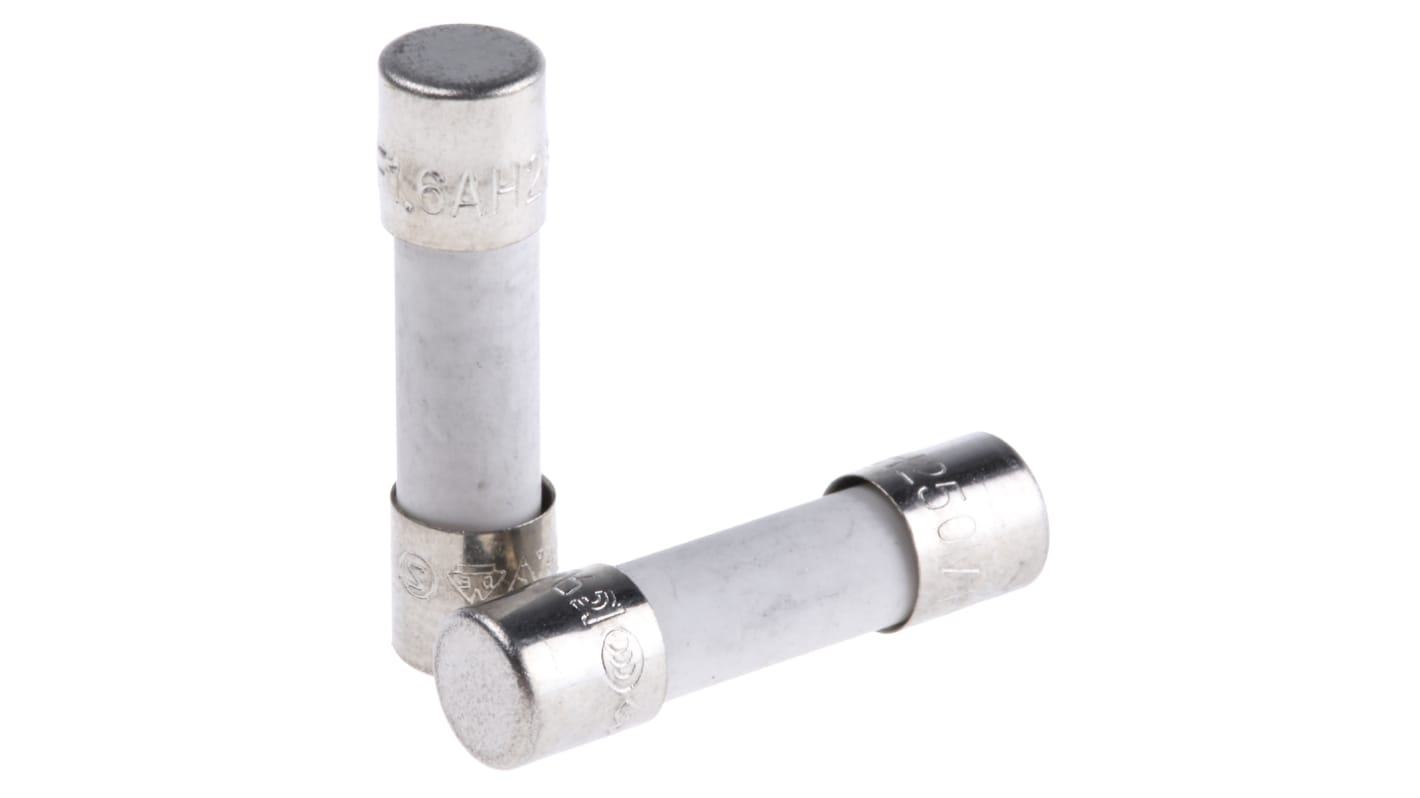Littelfuse 1.6A F Ceramic Cartridge Fuse, 5 x 20mm
- RS Stock No.:
- 725-8041
- Mfr. Part No.:
- 021601.6MXP
- Brand:
- Littelfuse

Subtotal (1 bag of 10 units)*
£13.01
(exc. VAT)
£15.61
(inc. VAT)
FREE delivery for orders over £50.00
In Stock
- 540 unit(s) ready to ship
- Plus 20 unit(s) ready to ship from another location
- Plus 1,000 unit(s) shipping from 14 April 2026
Need more? Click ‘Check delivery dates’ to find extra stock and lead times.
Units | Per unit | Per Bag* |
|---|---|---|
| 10 + | £1.301 | £13.01 |
*price indicative
- RS Stock No.:
- 725-8041
- Mfr. Part No.:
- 021601.6MXP
- Brand:
- Littelfuse
Specifications
Technical Reference
Legislation and Compliance
Product Details
Find similar products by selecting one or more attributes.
Select all | Attribute | Value |
|---|---|---|
| Brand | Littelfuse | |
| Current Rating | 1.6A | |
| Fuse Size | 5 x 20mm | |
| Fuse Speed | F | |
| Voltage Rating | 250V ac | |
| Body Material | Ceramic | |
| Series | 216 | |
Select all | ||
|---|---|---|
Brand Littelfuse | ||
Current Rating 1.6A | ||
Fuse Size 5 x 20mm | ||
Fuse Speed F | ||
Voltage Rating 250V ac | ||
Body Material Ceramic | ||
Series 216 | ||
Quick Acting (F) HBC– Ceramic Fuses
Ceramic fuses are great for short-circuit protection of semiconductors such as thyristors, diodes and triacs. Available in a range of current ratings with varying resistance values, this range are reliable for a broad range of applications. Note that fuses with values greater than 6.3A using open type fuse holders is recommended, to reduce the risk of nuisance tripping at or near full rated current.
Why choose ceramic cartridge fuse?
Ceramic and glass cartridge fuses have similar properties. The capacity of a ceramic cartridge fuse is higher than other fuses such as a glass fuse. This means ceramic fuses can be used in circuits that have a higher current and are perfect for protecting against overheating.
What size is it?
Sizes 8 x 32 mm, 10x38 mm, 14x51 mm & 22x58 mm in both Class gL-gG and aM are also available with a built-in striker for micro-switch operation and remote indication. Class gL-gG and aM fuse links are intended for industrial applications. All industrial fuse links are available with an operated visible fuse indicator.
What is Breaking Capacity?
Breaking capacity is the level of current that the fuse can safely handle without exploding or breaking. The breaking capacity of your fuse should be greater than the fault current of your electronic circuit.
What are fuses used for?
• For the protection of components and equipment from costly damage used by over-current
• To isolate sub-systems from the main system once a fault has appeared
What is on overcurrent?
It is a setting where a circuit experiences a current that is higher than the normal operating current.
Ceramic and glass cartridge fuses have similar properties. The capacity of a ceramic cartridge fuse is higher than other fuses such as a glass fuse. This means ceramic fuses can be used in circuits that have a higher current and are perfect for protecting against overheating.
What size is it?
Sizes 8 x 32 mm, 10x38 mm, 14x51 mm & 22x58 mm in both Class gL-gG and aM are also available with a built-in striker for micro-switch operation and remote indication. Class gL-gG and aM fuse links are intended for industrial applications. All industrial fuse links are available with an operated visible fuse indicator.
What is Breaking Capacity?
Breaking capacity is the level of current that the fuse can safely handle without exploding or breaking. The breaking capacity of your fuse should be greater than the fault current of your electronic circuit.
What are fuses used for?
• For the protection of components and equipment from costly damage used by over-current
• To isolate sub-systems from the main system once a fault has appeared
What is on overcurrent?
It is a setting where a circuit experiences a current that is higher than the normal operating current.
Approvals
VDE, SEMKO, UL, CSA
Very high breaking capacity
Good mechanical/vibration characteristics
Good mechanical/vibration characteristics
Typical Applications include short-circuit protection of semiconductors such as thyristors, diodes and triacs.
Note that with values of greater than 6.3A the use of open type fuseholders is recommended, to reduce the risk of nuisance tripping at or near full rated current.
Note that with values of greater than 6.3A the use of open type fuseholders is recommended, to reduce the risk of nuisance tripping at or near full rated current.
